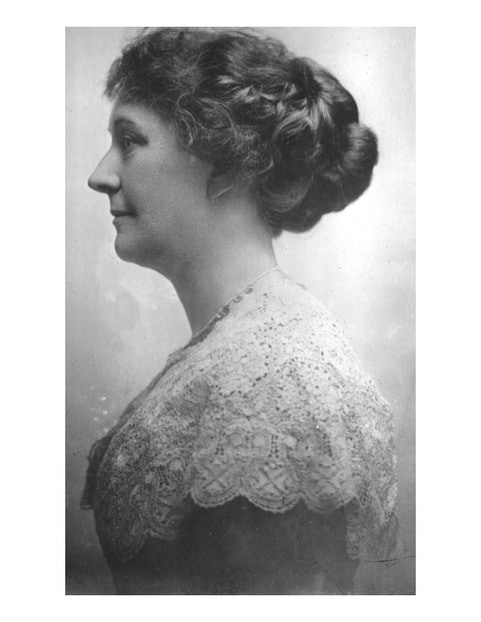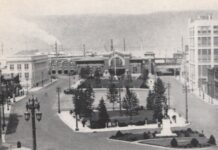
Henrietta Well Livermore
Part One: The Early Years
By Mary Hoar, Yonkers Historian
A friend to Republican presidents Calvin Coolidge, Warren Harding and Herbert Hoover, Henrietta Well Livermore was born in 1864 in San Francisco to Henry and Maria Wells, the fourth of five children.
Her father Henry came from a distinguished Massachusetts family and moved to California in his twenties in 1849; according to family legend, he was attracted by the Gold Rush. A year later when California became a state (1850), he became Deputy Clerk in the District Court. While working as a Court Clerk, he studied law and passed the Bar, developing a successful law practice… and success as a community volunteer. Active in the San Francisco community, he was elected President of the local Board of Education, Police Commissioner and President of the YMCA. During Lincoln’s presidency, he served as Chairman of the Republican Committee of the City and County of San Francisco, and was elected a Judge in 1863.
Wells moved his family back to Massachusetts in 1866. Continuing political activity while practicing law, he was elected to both the Massachusetts State Assembly (1880-1882) and the State Senate (1883, 1885). A Presidential Elector on the Republican Ticket in 1888, he was chosen Secretary of the Electoral College of Massachusetts, January 1889.
Henrietta received a top private education at Harvard Grammar School and the Cambridge Latin School and received her BA from Wellesley College in 1887. She married Dartmouth grad Arthur Livermore in 1890 and the couple moved to Texas where he practiced Law. After a few years, the couple went back to Massachusetts.
Henrietta returned to Wellesley, both giving birth and earning her master’s degree in 1893. Shortly afterwards, the Livermore family moved to Yonkers to establish Arthur’s law practice.
The couple was socially active from the time they moved here. They held literary evenings, hosting well known poets. Henrietta immersed herself in Local causes. Arthur, a successful New York lawyer, was very involved in St. Andrew’s Golf Club and an excellent golfer; drafted for their golf team, he served as team captain and traveled for competitions.
The couple had two sons, Henry and Russell, and purchased a house on Park Avenue, property bordering on then St. Andrew’s Golf Club. The couple lived there for the rest of their lives.
She contributed an article titled “The People’s University,” to “Woman’s Venture,” the book written by many of Yonkers’ well educated, prominent women; its “front piece” was a photograph by internationally famous Yonkers photographer Rudolf Eickemeyer. The book’s price of 25 cents benefited the Homeopathic Hospital and Maternity. This book had a place of honor on the book table next to Allison’s “History of Yonkers,” at the St. John’s (Hospital) Fair. Henrietta advocated cooperative housekeeping, believing if 25 families banded together, they could save up to 15 % on their supplies. Even more would be saved if a few cooks made meals for the entire group of families!
Mrs. Livermore was president of the New York Wellesley Alumni Association and organized stimulating programs on literature and current events. She made presentations for the Association of Collegiate Alumnae and studied vocal music with the esteemed Mary Hamilton Lawton. Mrs. Livermore, an active member of the Woman’s Institute, focused her presentations to its members on literature and music. She was the official Tuesday Club of Yonkers delegate to the New York State Federation of Women’s Clubs; this state organization focused on literature, philanthropy, municipal improvements, and art, including industrial art.
One of her favorite causes was the Fairview Garden School; it provided garden plots for children to grow flowers and vegetables in the spring and summer while spending time outdoors in the fresh air, and a clubhouse for them in the winter. She considered Fairview “a happy mingling of play and work, vacation and school, athletics and manual training, pleasure and business, beauty and utility.” Henrietta remained “interested” in Fairview, even when absorbed in the battle for a woman’s right to vote.
She headed the Civic League’s “School Visiting Committee;” during her tenure it became the Education Committee to reflect the committee’s expanded vision. Among committee accomplishments were presenting school assemblies; advocating for vocational training; supporting teaching English language; and promoting the use of sanitary drinking cups in schools. Other successes were formation of the Yonkers Teaching Training School (opened 1909 at School 18) and arranging for the Russell Sage Foundation Trust’s purchase of land to put the Fairview Garden School on a “secure financial basis,” making it the “foremost one of its kind,” according to Mrs. Livermore’s February 1910 report.
She was instrumental in forming the Yonkers Branch of the State Consumers’ League and was an active member of the Terrace City Sunshine Society.
By March 1910, her focus expanded to obtaining the vote for women. She became Yonkers representative to the Westchester County Woman’s Suffrage Association and served on its Executive Committee. This passionate advocate held a meeting of Yonkers’ women in her Park Avenue home on March 4th; they organized the Yonkers Woman Suffrage Association, and elected Henrietta President. Ten days later, the new group hosted a gathering, dubbed by the Yonkers Herald as the “largest meeting ever held in this city for woman suffrage” at the Amackassin Club. Attended by 500 people, many from “Yonkers Society,” chairs were jammed into the ballroom. Another report had closer to 700 people attending. The Yonkers Herald noted the speech of Keynote speaker Carrie Chapman Catt brought thunderous applause… from the men!
Henrietta’s life became filled with holding meetings, attending meetings, and making passionate speeches on women’s right to vote, including at the 1910 State Suffrage convention in Niagara Falls. She was appointed to several positions in the New York State Woman Suffrage Association and elected to several offices including Vice President.
Women in North Yonkers became energized and formed their own affiliated group to further the cause, the Palisade Suffrage Club. With other suffragists, Henrietta met with former Mayor Michael Walsh who was attending the Democratic National Convention. Although not an official delegate, this strong supporter of women’s right to vote promised he would try to get suffrage onto the official platform.
She became well known in the movement and suffrage celebrities came to Yonkers. Dorothy Dix and her humorous monologue was the highlight of one Yonkers Woman’s Suffrage Association December 1911 meeting. Mary Ware Dennett, National Secretary of the Woman’s Suffrage Association, spoke about the progress of the suffrage movement throughout the nation. NYC’s Mrs. Finch, tied women’s suffrage to business, pointing out, “The right to vote is the laboring man’s greatest protection.” Livermore worked closely with Carrie Chapman Catt, Susan B. Anthony’s choice to lead the National American Women’s Suffrage Association (NAWSA). Henrietta was appointed chair of NAWSA’s Literature Committee, responsible for creating, publishing and distributing suffrage literature throughout the country.
The Yonkers Woman Suffrage Association opened permanent headquarters at 67 South Broadway opposite the Public Library November 1912. Speakers celebrating the opening were: Rev. Arbuckle, Baptist Church of the Redeemer; Rev. Twamley, St. Andrew’s Memorial Church; Mrs. Livermore; Mrs. Robinson; Homer Folks (Secretary of the New York Charities Aid Association and Chair of the New York State Probation Association); and former Mayor Michael Walsh.
Her debate with prominent Anti-Suffragist Mrs. William Forse Scott was held at the Amackassin Club to raise money for the Garden School. In the midst of all this work, she added a few new local projects including the Yonkers Committee for a Safe and Sane Fourth of July, the Women’s Auxiliary to the Tuberculosis Dispensary, and advocated for the purchase of the Copcutt property to create an accessible park for “people in the tenements.”
Yonkers Suffragists issued “The-Up-To-Date-Woman” January 1914 to educate people on what the real issues were. This sixteen-page paper featured articles by some of Yonkers’ most prominent women in Yonkers, such as Mrs. Leo Baekeland, Sara McPike, Mrs. William Ives, and many others. So many people wanted to read it, the papers disappeared in just one day. It was popular and generated a lot of interest, it was attacked by anti-suffragist Mrs. William Forse Scott in a letter sent to Yonkers papers; this was the same woman Henrietta had debated in the past.
Mrs. Livermore and Mrs. Robinson continued to speak to the people of Yonkers. The Men’s Forum of St. Andrew’s Memorial Church invited them to address their club at a monthly meeting; a large, receptive audience attended the presentation given by the two women. The Modern Woodmen of America, Daughters of Scotia, the Grey Oaks Club the Knights of Columbus and many other local organizations asked Livermore, Robinson, and other local suffragists to address meetings.
Whatever the size of the meeting, whether a large gathering at the Elks Club or a small school PTA meeting, Henrietta was there to explain why she believed women should have the right to vote.
Next Week, Part 2: Success Through Education





